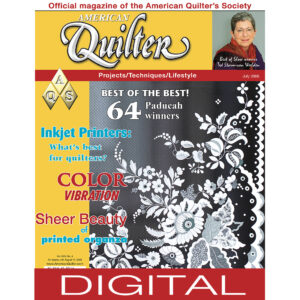We’re celebrating our 35th anniversary here at American Quilter’s Society, and it has us looking back at the trends that have shaped the quilting world and the trends of the moment fueling the future of quilting. This month, we’re trying Foundation Paper Piecing .
Foundation Paper Piecing is one method quilters use for accurate results and piecing odd angles. Here are three quilts from Fall Paducah 2019 QuiltWeek contestants that feature Foundation Paper Piecing (FPP).
How to Try This Trend
Foundation Paper Piecing
VIDEO
Watch How to Foundation Paper Piece or click here for a photo tutorial
Try starting with a traditional block like Storm At Sea if you’ve never Foundation Paper Pieced. Click Here for the pattern!
Make Your Own FPP Patterns
Outline
Part of the appeal of FPP is being able to depict people, places and things. All you need to start making your own FPP patterns is some paper, pens and pencils, a ruler, and a picture.
Here I have a free use photo of a maple leaf from photographer Oziel Gómez. Remember to respect fellow artists when creating!
Tape your image to a hard surface to prevent shifting. Using a light table or window is suggested.
Tape copy paper or tracing paper over the image.
With our light table, the leaf is visible through copy paper. Using copy paper is handy for any erasing that is needed later in the design process.
Map out the perimeter of the block with a ruler and pencil or pen.
Look at the image and start to find natural intersections where a line can be drawn from one edge of the perimeter to the other. Mark these lines with pencil.
Keep making lines that start at one line and extend to the perimeter. Don’t worry about finer details yet.
Next, using a lighter line or an erasable colored pencil, mark out more lines, again, making sure lines extend from one line to the other or to the perimeter. It’s best to mark these lines in a lighter shade because they are most likely to be changed during the design process. Repeat this process until you are satisfied.
Sections & Numbering
With all the lines marked, start identifying sections by determining how much of an area can be sewn in a single piece. Mark out these sections in a different color. Here the first section has been lined out in red.
Next, look within a section to determine the sewing order. One way to do this is to find Ts and Hs. Here I have marked two T shapes at the intersection of some lines. All three of the intersecting lines make a capital H shape. Anything under the top of the T shapes needs to be pieced first, and in an H shape like this it’s up to personal preference whether to start with the shape that’s the leaf or the background.
If during this process, you find a line or shape cannot be pieced as drawn, erase the line and redraw.
It can be helpful to letter sections, and then number. This is section A, and A1 would be the first piece laid onto the foundation, followed by A2 and so on.
Once the pattern is drawn as a whole, you can copy individual sections and add a 1/4″ seam allowance around it for ease of use. Save these section illustrations, draw a 1″ square on the same page, and save them to print yourself copies if you plan to use the pattern more than once. To make the finished block oriented the same direction as the picture, create mirrored versions of the section pieces before piecing.
Have fun with the design process. You will learn a lot about your preferences with sections, numbering and how to carve out shapes as you sew your own designs.
If you’d like to make the maple leaf pattern, click here to download the PDF!
Ready for more inspiration?
Check out our Must-Try Pinterest board
Have you tried this trend? Show us your creations in our Facebook group, AQS Quilting Project Parade
 American Quilter Magazine July 2008 Digital
1 × $6.99
American Quilter Magazine July 2008 Digital
1 × $6.99  American Quilter Magazine January 2011 Digital
1 × $6.99
American Quilter Magazine January 2011 Digital
1 × $6.99